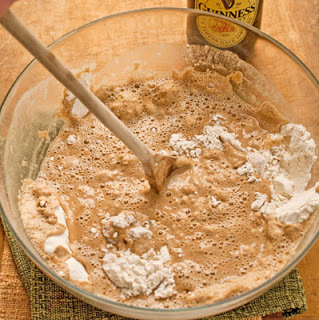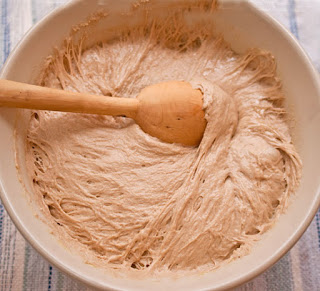
| Guinness Extra Stout No-Knead Yeast Bread |
Author: Nancy Baggett
I suspect you could use another brand of stout or a very dark beer in this recipe, but I like the results of the Guinness Extra Stout a lot so haven’t tried to substitute. I call for an entire bottle partly for the full-bodied flavor this amount imparts, but also because the stout immediately forms a generous head when poured, which makes it hard to measure. If you use a different sized bottle and have to measure out the 2¾ cups, you’ll need to pour it out into a large measure well ahead of time, then return it to the refrigerator and wait until the foam subsides to get an accurate take on the quantity.
To keep preparations as absolutely simple as possible, once the dough is stirred together and covered, I just put it aside in a chilly (60-degree F) room and let it rise, completely unattended, for about 24 hours. If you don’t have a garage, unheated sun room, basement, or other spot quite this cool, the dough will rise faster, so check to see if it is bubbly all over and tripled in bulk after 18 hours. In any case, don’t skimp on the rising time, as this allows for the fullest gluten development (visible in the stirred-down dough at right) and yields the noticeably chewy, springy crumb. Before baking the dough will smell of stout and taste strong, but somehow the heat gentles and sweetens it nicely in the oven.
To keep preparations as absolutely simple as possible, once the dough is stirred together and covered, I just put it aside in a chilly (60-degree F) room and let it rise, completely unattended, for about 24 hours. If you don’t have a garage, unheated sun room, basement, or other spot quite this cool, the dough will rise faster, so check to see if it is bubbly all over and tripled in bulk after 18 hours. In any case, don’t skimp on the rising time, as this allows for the fullest gluten development (visible in the stirred-down dough at right) and yields the noticeably chewy, springy crumb. Before baking the dough will smell of stout and taste strong, but somehow the heat gentles and sweetens it nicely in the oven.
Ingredients
- 5 cups (25 ounces) unbleached all-purpose white flour, plus more as needed
- 1 teaspoon rapid rising, bread machine, or “instant,” yeast
- 1 1-pint, 6-ounce bottle well-chilled Guinness Extra Stout
- ¼ cup clover honey or other mild honey
- 1 tablespoon canola or similar vegetable oil, plus more for brushing dough top
- 2 teaspoons plain table salt
Instructions
First rise:
- In a large bowl thoroughly stir together the flour and yeast. In a small, deep bowl, thoroughly stir together about ½ cup stout, the honey, oil and the salt until the honey is thoroughly incorporated into the stout. Add the remainder of the bottle of stout and the stout-honey mixture to the flour mixture. Vigorously stir with a large wooden spoon until the bubbling subsides and the dough is thoroughly blended. It should be stiff and hard to stir; if the dough is soft and wet, vigorously stir in more flour until it is hard to stir and mounds up a bit, but should not be dry.
- Thoroughly scrape down the bowl sides. Turn the dough out into a well-oiled 4-quart or larger bowl. Brush or spray the dough top with oil. Oil one side of a sheet of plastic wrap, then place it oil-side down over the bowl. Pull it tight over the bowl to keep the dough from drying out. Set the bowl in a 60-degree F (or similar) room and let the dough rise 18 to 24 hours or until bubbly and at least tripled in bulk.
Second rise:
- Vigorously and thoroughly stir down the dough with a large wooden spoon; it will feel rubbery and resistant as you stir. Brush and smooth the dough surface with oil. Re-cover the bowl with the oiled plastic wrap. Let rise using either of these methods: for a 1½- to 2½-hour regular rise, let stand at warm room temperature; for a 45-minute to 2-hour accelerated rise, let stand in a turned-off microwave along with 1 cup of boiling-hot water. Continue the rise until the dough doubles from the deflated size; remove the plastic if the dough nears it.
Baking Preliminaries:
- About 20 minutes before baking time, put a rack in the lower third (but not the very bottom) of the oven; preheat to 425 degrees F. Heat a 4-quart (or similar) heavy metal pot or Dutch oven or a deep 4-quart heavy, oven-proof saucepan in the oven until sizzling hot (check with a few drops of water), then remove it, using heavy mitts. Spritz the pot interior with non-stick spray (or wipe it with a few swipes of an oiled paper towel). Taking care not to deflate the dough, loosen it from the bowl sides with an oiled rubber spatula and gently invert it into the pot. Don’t worry if it’s lopsided and ragged-looking; it will even out during baking. Very generously spritz or brush the top with water. Immediately top with the lid. Shake the pot back and forth to center the dough.
Baking:
- Reduce the heat to 400 F. Bake on the lower rack for 55 to 60 minutes, or until the loaf top looks tawny brown and crisp. Remove the lid. Bake for 10 to 15 minutes longer, or until the top is well browned and a skewer inserted in the thickest part comes out clean except for a few crumbs on the tip (or until the center registers 208 to 210 degrees F on an instant-read thermometer). If the loaf begins to over-brown at any point, cover it with foil. And bake 5 minutes longer than you think the loaf needs to ensure the center is baked through. Cool in the pan on a wire rack. Remove the loaf to the rack. Cool thoroughly. Makes 1 very large loaf, 13 to 15 slices.
Notes

If you’re new to no-knead yeast bread, note that it’s the bubbling action during the long fermentation that actually kneads the dough. This recipe is similar to many in my Kneadlessly Simple: Fabulous, Fuss-Free, No-Knead Breads, in case you’re interested in trying other breads or learning more. For a tempting no-knead focaccia from the book, go here. For details on how my no-knead method works, go here.
Recipe by KitchenLane at https://kitchenlane.com/2013/03/st-paddys-day-stout-bread-as-in-bread.html